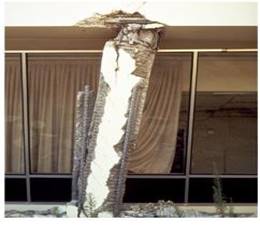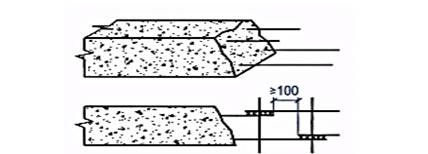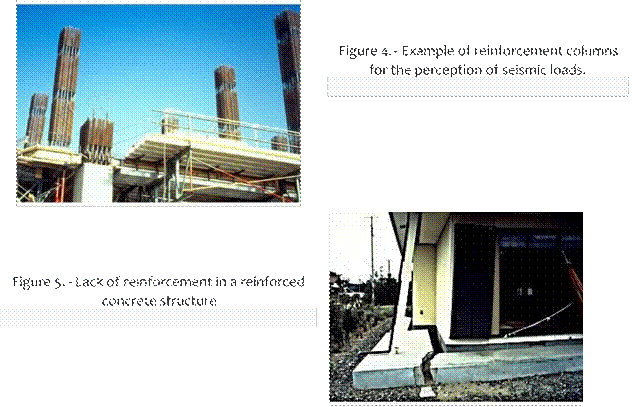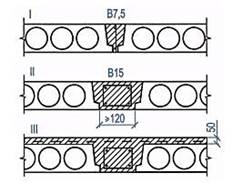

Journal Website:
https://theamericanjou rnals.com/index.php/ta jet
Copyright: Original content from this work may be used under the terms of the creative commons attributes
4.0 licence.
Connecting The Elements Of Reinforced Concrete
Structures Protection Of Reinforced Concrete Coverings
Candidate Of Technical Sciences, Associate Professor, Department Of Construction Of
Buildings And Structures, Fergana Polytechnic Institute, Fergana, Uzbekistan
Senior Lecturer, Department Of Construction Of Buildings And Structures, Fergana
Polytechnic Institute, Fergana, Uzbekistan
|
The article provides information on the characteristics of the design of reinforcement of flat-surface structures and welded welded rod structures in seismic areas. Recommendations with optimal solutions in problem solving are given.
KEYWORDS Design Of Reinforced Concrete Structures, Plane Structures, Bar Structures, Features Of |
Reinforcement, Connection Of Elements.
The joints of reinforced concrete structures must ensure reliable transmission of forces and the joint work of reinforced concrete elements; they should be located in places where the least effort is applied.
At 9 points, it is not allowed to use reinforcing ropes and rod reinforcement with a diameter of more than 28 mm without special anchors (since this is not economically viable due to the long anchoring length).
The angle of fracture of the axes of rod reinforcement of classes A500, A600, B500 and A400 (grade 25G2S) with a diameter of up to 40 mm, made by arc welding, should not exceed 60, and for other types of welding – 30In the meshes, it is allowed not to accidentally weld no more than 2% of the intersections of the rods, and in the frames all intersections must be welded. Cutting the ends of the rods with an electric arc during the assembly of structures or cutting the edges of the rods is not allowed
[1].
It should be noted that the replacement of conventional precast concrete products (most often floor slabs or columns) with prestressed ones has almost no effect on the seismic resistance of the structure and can be justified where there are restrictions on deflections or crack opening (should not be confused with technologies such as preliminary compression of the building as a whole or prefabricated floors of the entire floor with a ring cable).
In prestressed structures, it is not allowed to use reinforcement for which the relative elongation after rupture is less than 2%. When designing rod structures (beams, columns), according to recent publications, it is recommended to take into account the following features:
a) Longitudinal reinforcement must have a cross-sectional area of at least 0.1% of the element's cross-sectional area;
b) Transverse reinforcement in sections of the element with a length of 2h (where h is the height of the element section) adjacent to the rigid corners of the frames must meet the following requirements (where d is the diameter of the longitudinal reinforcement): - the step of the clamps should be no more than: - at 7 points - 1 / 2h, 15d, 150mm; - at 8 points - 1 / 3h, 12d, 100 mm; - with 9 points - 1 / 4h, 10d, 65 mm; - the diameter of the transverse reinforcement must be at least 8 mm [2,3,4.].

Figure 1. - Construction scrap: longitudinal reinforcement is broken; longitudinal and transverse reinforcement are not interconnected; longitudinal reinforcement has a bending stiffness greater than the concrete cover
c) Welded and mechanical joints of install additional transverse reinforcement longitudinal reinforcement can be in the joint area; performed in any section, and overlapping e) When connecting with an overlap in the joints should be located outside the zone bypass zone, frequent clamps should be of action of the maximum moments; installed with a pitch of at least h / 4, 8d and
d) For welded and mechanical joints of 100 mm; longitudinal reinforcement in each section, f) The ends of the knitted transverse no more than every second bar should be reinforcement clamps must be bent connected, while the distance between the around the longitudinal reinforcement bar joints along the length of the element must and inserted into the concrete core for a be at least 100 mm (Figure 2), and if the length of at least 6 dsw; bars are joined with eccentricity, then

Figure 2. – Connection longitudinal reinforcement
g) The ends are not brought into the concrete core; subsequent seismic failure; correct location of the clamps (Figure 3.)



The ends are not Subsequent seismic Correct arrangement routed inside the destruction of clamps concrete core
Figure 3. - Connection of transverse reinforcement
h) the length of welded seams and bypass of recommended to be taken 30% more than reinforcement when overlapping is that established by the joint venture
"Concrete and Reinforced Concrete
Structures" [5,6,8].
When designing planar structures (walls, diaphragms), it is recommended to take into account the following features:
• Along the edges of load-bearing wall elements, concentrated longitudinal vertical reinforcement with a crosssectional area of at least 0.05% of the crosssectional area of the wall should be provided;
• Along the field of the wall at both side faces, horizontal reinforcement with a total cross-sectional area of at least 0.1% of the area of the corresponding crosssection of the wall element should be provided;
• The reinforcement distributed along the lateral sides of the wall must be secured against buckling by means of special transverse rods;
• At the intersections of walls, in places of sharp changes in wall thickness and at the edges of openings, constructive
reinforcement should be provided;
• In the butt joints of wall elements, it is necessary to provide for the installation of reinforcing or other steel ties, securely behind the anchor ones in concrete. With a seismicity of 9 points for buildings with a height of 5 floors and higher, the crosssection of steel ties is taken to be at least 1 cm2 per 1 running meter. m of the joint, and at 7–8 points - not less than 0.5 cm2.

The axial compressive strength class of walls is established taking into account the concrete for external and internal load-bearing strength requirements for the main combination of loads, ensuring operational transportation and installation, but should not properties, conditions for stripping, be less than the values specified in Table 1.
Table 1 - Minimum classes of concrete for load-bearing walls of earthquake-resistant buildings

structural solutions for floors made of precast outlets or embedded parts on the ends (Figure concrete slabs with a corrugated or keyed 6).

Figure 6. - Types of precast concrete slabs.
Type 1. Seams between slabs are filled with cement or polymer-cement mortar, or finegrained concrete of class B 7.5 or higher. The slabs are anchored into anti-seismic belts, reinforced concrete straps or girders.
At the level of supporting the hollow-core panels, reinforced concrete straps are arranged on the crossbars of rectangular crosssection, reinforced along the intermediate frames with flat frames, and along the extreme end rows - with spatial frames.
When supporting hollow-core panels on the top of the crossbars, they must be provided with connections in the form of vertical outlets of reinforcement with a diameter of at least 16 mm with a step of 300-400 mm.
Type 2. Anchoring of slabs is provided in the same way as for type I. Floor slabs are laid with a distance of at least 120 mm.
Between the slabs, a reinforcement cage is installed with four longitudinal reinforcement rods with a diameter of 8 mm, which are anchored into antiseismic belts 35 or reinforced concrete straps. Monolithic concrete, fine-grained class B 15.
Type 3. Structural solutions for anchoring and embedding slabs are the same as for type 2, but, in addition, a 50 mm layer of fine-grained concrete of class B 15 or higher, reinforced with a mesh of reinforcement with a diameter of 4 mm with a cell of 500, is provided on the top of the floor. mm [7].
The support of floor slabs, depending on the type of supporting structures, should be taken at least: - on brick and stone walls - 120 mm; - on walls made of vibrated brick blocks - 90 mm; - for precast reinforced concrete girders - 80 mm; - on the walls of large-panel buildings: - when supported along the contour or on three sides - 60 mm; - when supported on two opposite sides - 90 mm; - on walls (diaphragms) made of monolithic reinforced concrete - 90 mm.
1. M. Martemyanov. Design and construction in seismic areas. M .: Stroyizdat, 1985.220 p.
2. Djurayevna, T. N. (2020). Influence Of Surface Additives On Strength Indicators Of Cement Systems. The American Journal of Applied sciences, 2(12), 81-85.
3. Djurayevna, T. N. (2020). Building Materials Determined In The
Architectural Monuments Of Central Asia. The American Journal of Applied sciences, 2(12), 77-80.
4. Ashurov, M., Sadirov, B. T., Xaydarov, A. M., Ganiyev, A. A., Sodikhonov, S. S., & Khaydarova Kh, Q. (2021). Prospects for the use of polymer composite fittings in building structures in the republic of Uzbekistan. The American Journal.
5. Ogli, X. A. M. (2021). Construction Of Flexible Concrete Elements In Buildings. The American Journal of Engineering and Technology, 3(06),
101-105.
6. Gayradjonovich, G. S., Mirzajonovich,
Q. G., Tursunalievich, S. B., & Ogli, X. A.
M. (2021). Corrosion State Of Reinforced Concrete Structures. The American Journal of Engineering and Technology, 3(06), 88-91.
7. Ogli, X. A. M. Development of effective cement additives for the production of heat-resistant concrete based on technogenic waste. International Journal of Researchculture Society.
India (2019. 12. 12).
8. Usmonov, Q. T., & Xaydarov, A. M. (2021). Yirik shaharlarda turar-joy maskanlari uchun xududlarni muhandislik tayyorgarlik va obodonlashtirish ishlarini amalga oshirish yo ‘llari. Scientific progress, 2(6), 1297-1304.
9. Mirzajonovich, Q. G., Ogli, A. U. A., & Ogli, Х. AM (2020). Influence Of Hydro
Phobizing Additives On
Thermophysical Properties And LongTerm Life Of KeramzitObetona In An Aggressive Medium. The American Journal of Engineering and
Technology, 2(11), 101-107.
10. Ogli, Х. AM, Ogli, AUA, &
Mirzajonovich, QG (2020). Ways Of Implementation Of Environmental Emergency Situations In Engineering Preparation Works In Cities. The American Journal of Engineering and Technology, 2(11), 108-112.
11. Ogli, Х. AM, Ogli, AUA, &
Mirzajonovich, QG (2020). Hazrati Imam Architecture The Complex Is A Holiday Of Our People. The American Journal of Engineering and
Technology, 2(11), 46-49.
12. Ogli, X. A. M. Development of effective cement additives for the production of heat-resistant concrete based on technogenic waste" International Journal of Researchculture Society.
India (2019. 12. 12).
13. Usmоnov, Q., & Хaydarov, A. (2021). The Methods for Implementing Engineering and Preparatory Works and Improvement in Cities. CENTRAL ASIAN JOURNAL OF THEORETICAL &
APPLIED SCIENCES, 2(11), 218-225.
14. Tolkin, A. (2020). Reconstruction of 5storey large panel buildings, use of atmospheric precipitation water for technical purposes in the building. The American Journal of Applied sciences, 2(12), 86-89.
15. Tolqin, A. (2021). Ancient greek and ancient rome architecture and urban planning. The American Journal of Engineering and Technology, 3(06), 8287.
16. T. Axmedov GOTIKA USLUBINING
ARXITEKTURADAGI AHAMIYATI // Ilmiy taraqqiyot. 2021 yil. 6-son. URL: https://cyberleninka.ru/article/n/gotika -uslubining-arxitekturadagi-ahamiyati (kirish sanasi: 10.12.2021).
17. Ibrohim Numanovich Abdullayev, Azizxon Abbosxonovich Marupov, Tulqin Ahmedov. (2020). Analysis of land in protected areas of gas pipelines of different pressure on the example of the ferghana region. EPRA International Journal of
Multidisciplinary Research+ (IJMR+) - Peer Reviewed Journal, 6(5), 311-314.
18. Usmonjon Turgunaliyevich Yusupov, 2 Akhmedov Tulkin Obidovich. (2019). Development of polyfunctional additives based on secondary resources and technologies of portland cement production. INTERNATIONAL JOURNAL OF RESEARCH CULTURE
SOCIETY, 3(12), 200-208.
19. Nabiev, M., GM, G., & Sadirov, B. T. (2021). Reception of improving the microclimate in the houses of the fergana valley. The American Journal.
20. Abdukhalimjohnovna, M. U. (2021). Technology Of Elimination Damage And Deformation In Construction Structures. The American Journal of Applied sciences, 3(5), 224-228.
21. Mirzaahmedov, A. T. (2020). Algorithm For Calculation Of Multi Span Uncut Beams Taking Into Account The Nonlinear Work Of Reinforced Concrete. The American Journal of Applied sciences, 2(12), 26-35.
22. Мирзаахмедов, А. Т.,
Мирзаахмедова, У. А., & Максумова, С. Р. (2019). Алгоритм расчета предварительно напряженной железобетонной фермы с учетом нелинейной работы железобетона.
Актуальная наука, (9), 15-19.
23. Mirzaakhmedova, U. A. (2021).
Inspection of concrete in reinforced concrete elements. Asian Journal of Multidimensional Research, 10(9), 621628.
24. Abdukhalimjohnovna, M. U. (2020). Failure Mechanism Of Bending Reinforced Concrete Elements Under The Action Of Transverse Forces. The American Journal of Applied sciences, 2(12), 36-43.
25. Mirzaahmedov, A. T. (2020).
Accounting For Non-Linear Work Of Reinforced Concrete In The Algorithms
Of Calculation And Design Of Structures. The American Journal of Engineering and Technology, 2(11), 5466.
26. Мирзаахмедов Абдухалим
Тахирович, & Мирзаахмедова Угилой Абдухалимжановна (2019). Алгоритм расчета железобетонных балок прямоугольного сечения с односторонней сжатой полкой. Проблемы современной науки и образования, (12-2 (145)), 50-56.
27. Mirzaeva, Z. A. (2021). Improvement of technology technology manufacturing wood, wood with sulfur solution. Asian Journal of Multidimensional Research, 10(9), 549-555.
28. Мирзаева Зарнигор Алишер Кизи, & Рахмонов Улмасбек Жуманазарович (2018). Пути развития инженерного образования в Узбекистане.
Достижения науки и образования, 2
(8 (30)), 18-19.
29. Goncharova, N. I., Abоbakirova, Z. A., & Kimsanov, Z. (2019). Technological Features of Magnetic Activation of Cement Paste" Advanced Research in Science. Engineering and Technology, 6(5).
30. Махкамов, Й. М., & Мирзабабаева, С. М. (2019). Прогибы изгибаемых железобетонных элементов при действии поперечных сил и технологических температур. Проблемы современной науки и образования, (12-2 (145)).
Материалы на данной страницы взяты из открытых источников либо размещены пользователем в соответствии с договором-офертой сайта. Вы можете сообщить о нарушении.